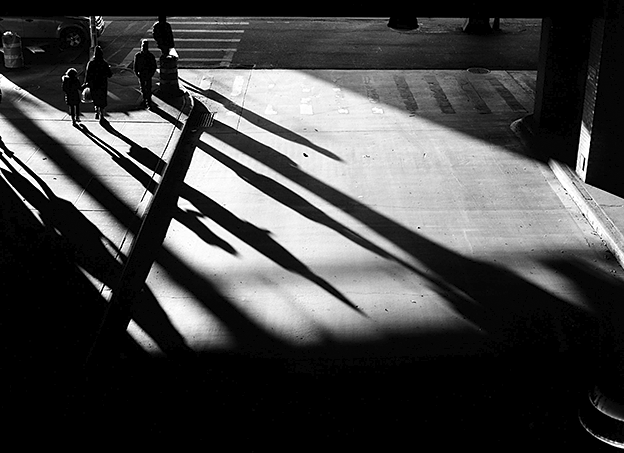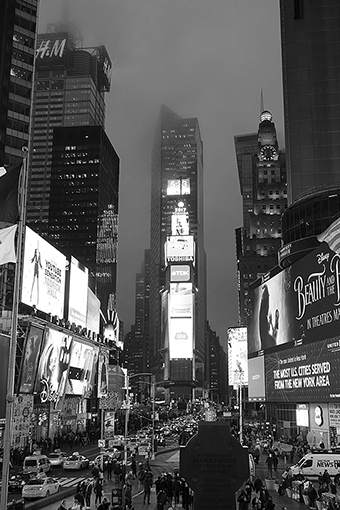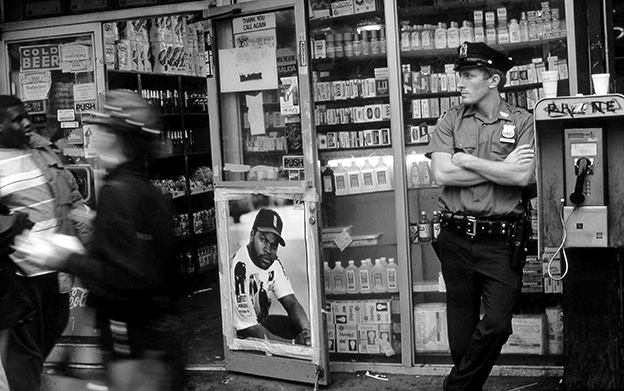
Those who feel they have reached the end of their tether after two years of pandemic-induced emergency rule may find consolation in the thought that things are far more uncomfortable elsewhere. In Gotham City, for example. In Batman’s home town, chaos is a daily occurrence. And the world watches; the world in an almost literal sense. Gotham first appears in the fourth issue of »Batman«, published in the winter of 1940/41, and ever since then, people across all continents have been taking an interest in the fate of the fictitious metropolis, home to millions. Even more so since its move to the silver screen: the last two films of Christopher Nolan’s »Dark Knight« trilogy alone raked in over a billion dollars each at the box office.
Gotham represents a permanent state of emergency, the rule of crime, and a mind-boggling level of failure on the part of the state. Yet it also stands for the triumph of a heroic form of republicanism as practised by its most prominent citizen, Bruce Wayne a.k.a. Batman. Which prompts the question: what is the special flavour of this society, what are the collective phobias that yield such a rich harvest?
In antiquity, the destruction, depredation or desecration of cultural sites frequently signified the utmost threat to the stability of state and society. This could justify almost any measure, even if from an objective military or police perspective the deed did not carry the relevance that was accorded to it, purely because of the symbolic value of the threatened object.
The world of the 20th and 21st centuries is located in a symbolic power field, just as it was in antiquity. This is manifested by two iconic Gotham landmarks, which criminals and terrorists love to get their hands on: Blackgate Prison, the infamous jail, and Arkham Asylum, the even more infamous psychiatric ward introduced to the comic book series in 1974, where villains such as the Joker and Two-Face are locked up.
Those buildings have an unsettling effect. They represent the latent fear, stoked by rumours and conjecture, of inmates who have cut all ties to society. They also embody the guilt trip of a citizenry that has no trust in the integrity of its justice system. They are toxic places in the heart of an unstable republic. Any failure of the protective barriers that separate those in power from those exiled here leads to the ultimate catastrophe. The psychological effect triggered by a sudden loss of control has left its mark on world history more than once – just consider the storming of the Bastille on 14th July 1789, or the seizing of the Kresty prison in St Petersburg during the February Revolution of 1917.
One could call it a trademark for Batman and his opponents that the common symbolism
of good and evil is rejected and reversed. Batman is the virtuous knight performing
good deeds, but his armour is black, while the Joker carries out his vile crimes in
a clown’s white make-up. Perhaps even more noticeable and influential than costumes
and camouflage is the systematic symbolic inversion of the city’s architecture and
event locations. The supervillains make a point of selecting public spaces for their
attacks, spaces that serve as inner-city oases and refuges for Gotham’s citizens who,
plagued by violence and social misery, hope to enjoy a few carefree hours, a time-out
from the stress and strain of their daily lives: the zoo, a circus, a stadium, museums,
botanical gardens.

Terror is brought precisely to the innermost sanctuary of innocence, to the inviolable, taboo core, the holy shrine of cultured society. Frequently the reason for this is that the perpetrators, for example the Joker, were deprived of such spaces during a childhood filled with violence. Those that pursue this course are assured of eternal enmity. Not a single step further, one wants to shout at them. It’s bad enough that you pick barracks, bars, petrol stations, public toilets or factory floors to stage your crimes, but stay away from humanity’s heartland! There are limits even for you, you must respect the tacit, minimal consensus of civilised peoples!
Thus one wants to appeal to them, but they lack any scruples; all they have is a highly
developed sense for the logic of escalation. And so they storm the sacred temples,
they deface invaluable artworks as if those were rusty dustbins, and at Christmas
they toss hand grenades into toyshop windows. Their deeds carry one message only:
forget the petty crimes on your streets, this, only this, is the state of emergency!
And as if all that wasn’t enough, Gotham is threatened to be utterly annihilated by the nuclear bombs of Ra’s al Ghul’s League of Assassins, the ice canon of Mr Freeze or similarly hellish contraptions. The myths and legends of Western civilisation are a treasure trove for tales about the violent demise of great urban centres. The devastation of Sodom and Gomorrah, the downfall of Babylon and Troy, the destruction of Carthage and Jerusalem, and the struggle for Rome in late antiquity: looking at these events one finds that those who suffer these terrible fates are most often portrayed as perpetrators rather than victims. They are used by God – or the Gods, fate, history, or the Weltgeist – to serve as an example for disobedience, depravity, iniquity. The catastrophe is intended as a beacon, a warning for future generations.
The topic of decadence is such an essential element of any tale of downfall or decline that in the case of a metropolis faced with attacks on its physical substance, its most important edifices, infinitely more is at stake than merely its continued existence. A city fighting against its destruction is always also fighting for its place in history, for its legitimation, its right to exist, in the past as in the present, for the right to survive as a memory of a place where life was good. A city that succumbs to destruction inflicts retroactive injustice on itself and anyone who ever lived there. This raises the stakes infinitely.
So the citizens of Gotham need to tough it out – and they need institutions that protect them from the worst, for they cannot count on help from the outside. Granted, the general take is that the city is legally part of the United States, and its streets are filled with people from all corners of the world. But national or international solidarity when the going gets tough? Negative. Moreover, in borrowing from New York, the map of Gotham designed by Eliot R. Brown in 1998 shows the city as a group of isles, an island just like Plato’s Atlantis and More’s Utopia, implying a self-centred orientation, a typically insular focus on oneself. If necessary, the tunnels and bridges connecting Gotham to the mainland can be blown up to really drive home the point that this is a city state of classic design.
So in this self-reliant republic, who can, who should take the lead in an emergency? Not Gotham’s regular institutions, that’s for sure; they offer a pitiful picture. The police can’t even handle run-of-the-mill crimes, let alone supervillains with superior intellect and equipment. The political and administrative institutions, to the degree that they’re not entirely paralysed by internal squab|bling, have to jump through complicated hoops to reach consensus and, as a consequence, their reactions to any kind of threat usually comes way too late.
In brief: this is more or less the situation described by Machiavelli with a view to the republics of antiquity and the Renaissance. The ordinary course of business was too slow, he complained, which posed enormous risks should they have to deal with a situation that suffered no delays. Therefore, so the recommendation by the political philosopher from Florence, the constitution should allow the establishment of a dictatorship for such situations of urgency. He referred to the eponymous institution under Roman law, not to the construct we nowadays associate with the term, not tyrannis, not despotism, not Caesarism. In ancient Rome, the dictator was a high-level magistrate; this was not a permanent position, and a dictator could be appointed only in specific circumstances, in particular in the event of war or internal unrest. The period of office was limited to six months.
And would you know it, Gotham does exactly what Machiavelli recommends: it adopts the ›Roman‹ solution. The magistrate appoints a trustworthy, capable citizen to save the fatherland, someone who in times of need takes the measures necessary to overcome the crisis. To bring this about, a representative of the citizenry climbs up to the roof of the police headquarters, switches on a spotlight, and delivers Gotham’s appeal for help and the task at hand to the bat thus attracted. Once the job is done, the saviour quickly withdraws, sheds his armour and all burden, and Bruce Wayne, independently wealthy, lives his quiet life in a grand mansion at the edge of the city.
This interpretation is supported by one of the key scenes in the »Dark Knight« trilogy: the argument between District Attorney Harvey Dent and his girlfriend Rachel, who questions Batman’s democratic legitimacy. Dent, on the other hand, does not hesitate to take the Dark Knight’s side and expressly places him in the tradition of ancient Roman dictatorship.

This take on republicanism focuses on the individuals’ duties rather than their rights. Its role model is the engaged citizen who gets involved in matters of state whenever it counts; it sees corruption, greed and abuse of power as the greatest vices and a sense of responsibility, incorruptibility and self-restraint as the greatest virtues. In general, everything revolves around virtue and personal proficiency – the Greek arete, the Roman virtus, the Florentine virtù. This does not mean that republicanism stands in direct contrast to liberalism, but it does place different emphases.
To therefore condemn it as reactionary, or ignore it entirely, would be a mistake. The US-American philosopher Robert Pippin made a valid point when he wondered whether the current tendency to question the legitimacy of everything and everyone wasn’t going a bit too far and in doing so neglected the actual business of political psychology. The question what type of psychological constitution is required for which political regime or form of government is one that we should still treat as relevant today.
And yet, we must not lose sight of the Achilles heel of republican heroism. The voluntary withdrawal after completion of the task is a tricky issue. Not only does it require the victorious heroes to admit that they are superfluous as of now. When the citizenry acquires a taste for its own powerlessness and feels quite at home therein, it is likely to simply let things run their own course. But that is not an option. Seeing oneself as at the mercy of Gods and superheroes is questioning one of the most important achievements of Greek and Roman antiquity: the discovery of politics as self-determined action.
Let us hope, then, that Batman’s fellow citizens will continue to find a way out of
this labyrinth of self-inflicted disempowerment and that we can spend another 80 years
admiring Gotham City’s glorious demise.
* Translation by Vera Mark. A slightly different German version of this article appeared in the Frankfurter Allgemeine Sonntagszeitung on 20 June 2021, p. 41, under the title »Wer den Ausnahmezustand beherrscht«. For a more in-depth analysis see Daniel Damler, Gotham City. Architekturen des Ausnahmezustands, Frankfurt am Main/New York 2022.